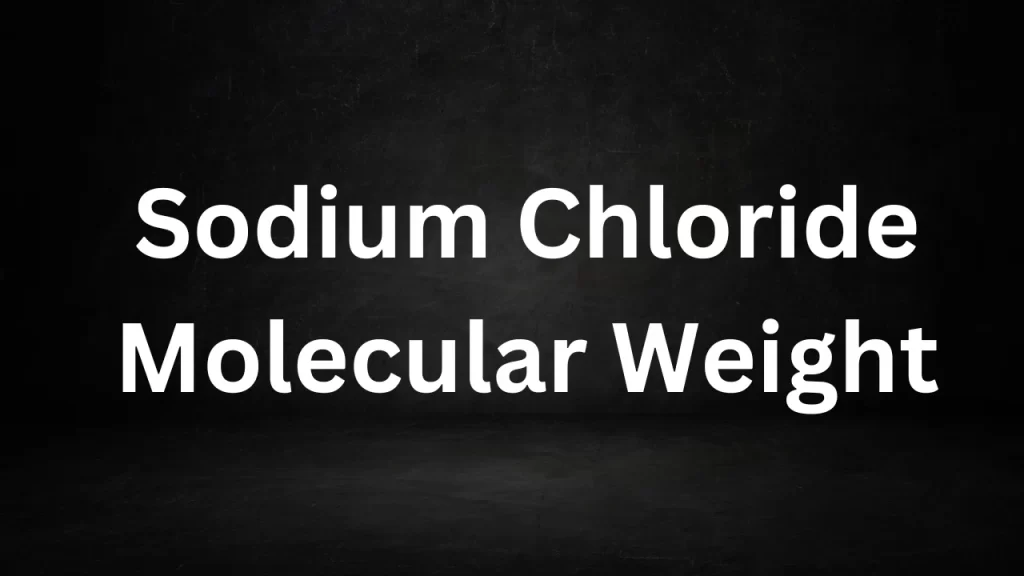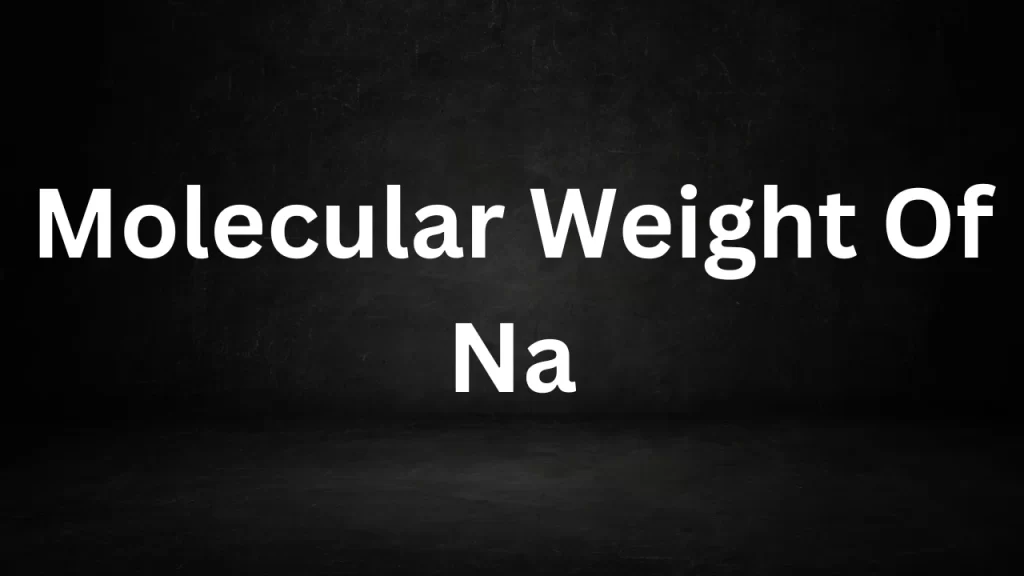Tag: na cl mw
Sodium Chloride Molecular Weight
Sodium Chloride Molecular Weight: Sodium chloride, commonly known as table salt, is a ubiquitous and essential compound in our daily lives. While it enhances the flavor of our food, it also plays a crucial role in various industries and scientific endeavors.
One fundamental aspect of sodium chloride is its molecular weight, which is a key factor in understanding its properties and applications. In this article, we will explore the molecular weight of sodium chloride and its significance in different fields.

Sodium Chloride Molecular Weight
The Composition of Sodium Chloride
Sodium chloride (NaCl) is a chemical compound composed of two elements: sodium (Na) and chlorine (Cl). It is an ionic compound held together by electrostatic forces due to the transfer of an electron from sodium to chlorine, resulting in the formation of positively charged sodium ions (Na+) and negatively charged chloride ions (Cl-).
Calculating the Molecular Weight
To determine the mole weight of sodium chloride (NaCl), we need to consider the atomic masses of sodium and chlorine. Sodium (Na) has an atomic mass of approximately 22.98977 atomic mass units (amu), while chlorine (Cl) has about 35.453 amu.
The molar mass, also called the mole weight or molar weight, of sodium chloride is determined by summing the atomic masses of its component elements.
Molecular Weight of NaCl = Atomic Mass of Na + Atomic Mass of Cl Molecular Weight of NaCl ≈ 22.98977 amu + 35.453 amu Molecular Weight of NaCl ≈ 58.44277 amu
Hence, sodium chloride (NaCl) has a molar mass of about 58.44277 atomic mass units (amu) or 58.44277 grams per mole (g/mol).
Significance of Sodium Chloride’s Molecular Weight
- Chemical Reactions: The mole weight of sodium chloride is crucial in various chemical reactions, especially in stoichiometry, where it helps determine the reactant ratios and the amount of product produced.
- Industrial Applications: In industries such as food processing, pharmaceuticals, and water treatment, knowing the mole weight of sodium chloride is vital for precise measurements and formulations.
- Health and Nutrition: Sodium chloride is a vital dietary component, and knowledge of its molecular weight aids dietary calculations, particularly for those with restrictions.
- Analytical Chemistry: In analytical chemistry, sodium chloride’s molecular weight is utilized, particularly in titration, as a primary standard for solution standardization.
- Salt in Solutions: The molar mass of sodium chloride is crucial for comprehending colligative properties in solutions, relevant in science and industry.
Conclusion
Sodium chloride, with its precise mole weight of approximately 58.44277 amu, significantly impacts chemistry, industry, and daily living. Its mole weight is a key factor in chemical reactions, industrial processes, dietary considerations, and analytical techniques. From seasoning meals to advancing science, sodium chloride’s molecular weight plays a vital role in various aspects of our world.
Read More
- Equivalent Weight Of CaCO3
- Benzoic Acid Molar Mass
- Sulfuric Acid Molar Mass
- Discrete Mathematics For Computer Science
- Molecular Mass of Carbon Dioxide
Frequently Asked Questions (FAQs) On Sodium Chloride Molecular Weight
1. What is sodium chloride?
Sodium chloride (NaCl) is a chemical compound commonly known as table salt. It is composed of sodium (Na) and chlorine (Cl) ions.
2. What is the molecular weight of sodium chloride?
The mole weight of sodium chloride (NaCl) is approximately 58.44277 atomic mass units (amu) or 58.44277 grams per mole (g/mol).
3. How is the molecular weight of sodium chloride calculated?
To calculate the mole weight of sodium chloride, you add the atomic masses of its constituent elements, sodium (Na) and chlorine (Cl).
4. Why is knowing the molecular weight of sodium chloride important in chemistry?
Sodium chloride’s molecular weight is essential for stoichiometry, determining reactant ratios, and understanding chemical reactions. It is also crucial in various industries and scientific fields.
5. In which industries is the knowledge of sodium chloride’s molecular weight significant?
Sodium chloride’s molecular weight is crucial in industries like food processing, pharmaceuticals, water treatment, and chemical manufacturing, requiring precision.
Molecular Weight Of Cl
Molecular Weight Of Cl: Chlorine (Cl) is a chemical element with atomic number 17, making it one of the halogens in the periodic table.
It is a highly reactive and essential element used in various industries, including water treatment, chemical manufacturing, and the production of plastics. Understanding the molecular weight of chlorine is fundamental in chemistry, as it aids in various calculations and chemical reactions. In this article, we will explore the concept of molecular weight, discuss its significance in chemistry, and calculate the molecular weight of chlorine.

Molecular Weight Of Cl
Molecular Weight: An Important Concept
Mole weight, also known as molen mass or molar mass, is a crucial concept in chemistry. It represents the mass of one mole of a substance and is typically expressed in atomic mass units (amu) or unified atomic mass units (u). Calculating the molecular weight of a chemical element or compound involves summing the atomic masses of all the constituent atoms according to their proportions in the chemical formula.
Calculating the Molecular Weight of Chlorine
To calculate the mole weight of chlorine (Cl), we can use its atomic mass. The atomic mass of chlorine is approximately 35.45 atomic mass units (amu) or unified atomic mass units (u). Since chlorine exists as single atoms (Cl) and not as diatomic molecules (Cl2), its molecular weight is the same as its atomic mass.
Mole Weight of Chlorine (Cl) = Atomic Mass of Chlorine (Cl) Mole Weight of Chlorine (Cl) = 35.45 amu or 35.45 u
So, the mole weight of chlorine (Cl) is approximately 35.45 amu or 35.45 u.
Significance of Chlorine Molecular Weight
The mole weight of chlorine holds significance in various aspects of chemistry:
- Stoichiometry: Mole weight is essential in stoichiometry, allowing chemists to balance chemical equations and determine the quantities of reactants and products involved in chemical reactions that include chlorine.
- Chemical Reactions: Understanding the mole weight of chlorine aids in predicting its behavior in chemical reactions, calculating reaction yields, and determining product formation.
- Water Treatment: Chlorine is commonly used for water disinfection in municipal water treatment plants. Its molecular weight is important for accurately dosing chlorine to ensure safe drinking water.
- Chemical Manufacturing: Chlorine is a key raw material in various chemical processes, including the production of PVC (polyvinyl chloride) and chlorine-based solvents. Knowledge of its mole weight is crucial for quality control and process optimization.
- Analytical Chemistry: In analytical chemistry, mole weight measurements are often used for the identification and quantification of substances.
Conclusion
The mole weight of chlorine (Cl) is a fundamental concept in chemistry, with practical implications in various applications. By calculating its mole weight, chemists can make informed decisions, conduct precise experiments, and ensure the efficient utilization of chlorine in chemical processes, water treatment, and industrial applications. This understanding highlights the importance of mole weight in chemistry, allowing us to comprehend and control element properties effectively.
Read More
- Molecular Mass Of Sodium Carbonate
- Molecular Mass Of Nitric Acid
- Molecular Mass Of Sulphuric Acid
- Molar Mass Of Sulphuric Acid
- Types Of Motion In Physics
Frequently Asked Quetions (FAQs) OnMolecular Weight Of Cl
1. What is the molecular weight of chlorine (Cl)?
The mole weight of chlorine (Cl) is approximately 35.45 atomic mass units (amu) or unified atomic mass units (u).
2. What is molecular weight, and why is it important in chemistry?
Mole weight, also known as mole mass or molar mass, represents the mass of one mole of a substance and is expressed in atomic mass units (amu) or unified atomic mass units (u). It is crucial in chemistry for stoichiometry, balancing chemical equations, and various calculations.
3. How is the molecular weight of chlorine calculated?
The mole weight of chlorine is the same as its atomic mass, which is approximately 35.45 amu or 35.45 u. Chlorine exists as single atoms (Cl) and does not form diatomic molecules (Cl2).
4. Why is the molecular weight of chlorine significant in chemistry?
The mole weight of chlorine is important for stoichiometry, allowing chemists to balance chemical equations and determine reactant and product quantities accurately. It is also relevant in chemical reactions, water treatment, chemical manufacturing, and analytical chemistry.
5. Is chlorine always in its atomic form (Cl) in chemical reactions?
In most chemical reactions, chlorine exists as individual atoms (Cl) rather than diatomic molecules (Cl2). Therefore, its mole weight is equivalent to its atomic mass.
Molecular Weight Of Na
Molecular Weight Of Na: Sodium, with the chemical symbol Na and atomic number 11, is an essential element found in the Earth’s crust and oceans.
In this article, we will explore the molecular weight of sodium, its significance in chemistry, and its critical role in various biological and chemical processes.

Molecular Weight Of Na
The Ubiquitous Element: Sodium
Sodium is one of the most abundant elements on Earth, primarily occurring in the form of compounds like sodium chloride (table salt) and various minerals. It is a highly reactive metal that is never found in its pure form in nature due to its extreme reactivity with moisture and oxygen.
Molecular Weight of Sodium (Na)
The molecular weight of an element, often referred to as its atomic weight or molar mass, is defined as the mass of one mole of atoms of that element, measured in grams per mole (g/mol). To calculate the molecular weight of sodium (Na), we use its atomic mass:
- Sodium (Na) has an atomic mass of approximately 22.99 g/mol.
- The molecular weight of sodium is, therefore, approximately 22.99 grams per mole.
Significance of Molecular Weight in Chemistry
The molecular weight of sodium is a fundamental value in chemistry. It is used in stoichiometry, chemical calculations, and the formulation of chemical equations. Chemists rely on molecular weights to determine the quantity of sodium and other elements involved in chemical reactions, allowing for precise measurements and accurate predictions.
Sodium’s Role in Biology and Chemistry
Sodium plays pivotal roles in both biology and chemistry:
1. Biological Significance: Sodium is an essential electrolyte in the human body, critical for various physiological processes. It including nerve function, muscle contraction, and maintaining fluid balance. Sodium ions (Na+) are actively transported in and out of cells, contributing to electrical impulses and the transmission of signals in the nervous system.
2. Chemical Reactivity: Sodium is highly reactive, particularly in the presence of water. It vigorously reacts with water to produce sodium hydroxide (NaOH) and hydrogen gas (H2). This property makes sodium valuable in various chemical processes and industries.
3. Sodium Compounds: Sodium forms compounds with a wide range of elements, such as chlorine (NaCl), forming common table salt. These compounds have diverse applications in food, industry, and medicine.
Conclusion
The molecular weight of sodium (Na), approximately 22.99 g/mol, represents the mass of one mole of sodium atoms. This seemingly simple element is indispensable in the natural world, influencing both biological and chemical processes. Sodium’s importance in maintaining human health, its reactivity in chemical reactions. Its role in various compounds underscore its significance in our daily lives and in the broader fields of chemistry and biology.
Read More
- Molecular Mass Of O2
- Molecular Mass of H2
- Molecular Mass Of NH3
- Molecular Mass Of Ch4
- Nitric Acid Molar Mass
Frequently Asked Questions (FAQs) Molecular Weight Of Na
Q1: What is the molecular weight of sodium (Na)?
A1: The molecular weight of sodium (Na) is approximately 22.99 grams per mole (g/mol).
Q2: Why is the molecular weight of sodium important in chemistry?
A2: The molecular weight of sodium is important because it allows chemists to determine the mass of one mole of sodium atoms. Which is crucial for stoichiometry, chemical calculations, and the formulation of chemical reactions. It helps in understanding the quantity of sodium involved in various chemical processes.
Q3: Is sodium always found in compounds rather than in its pure form in nature?
A3: Yes, sodium is highly reactive with moisture and oxygen, so it is never found in its pure form in nature. Instead, it is typically found in the form of compounds, such as sodium chloride (table salt), sodium carbonate, and various minerals.
Q4: What is the significance of sodium in biology?
A4: Sodium is an essential element in biology, playing a crucial role in nerve function, muscle contraction, and maintaining fluid balance in the human body. Sodium ions (Na+) are involved in transmitting electrical signals in the nervous system.
Q5: How is sodium used in chemistry and industry?
A5: Sodium’s reactivity makes it valuable in various chemical processes and industries. It is used in the production of sodium hydroxide (NaOH), which is a key ingredient in the manufacture of soap, paper, and textiles. Sodium also has applications in metallurgy, organic synthesis, and as a reducing agent in some chemical reactions.